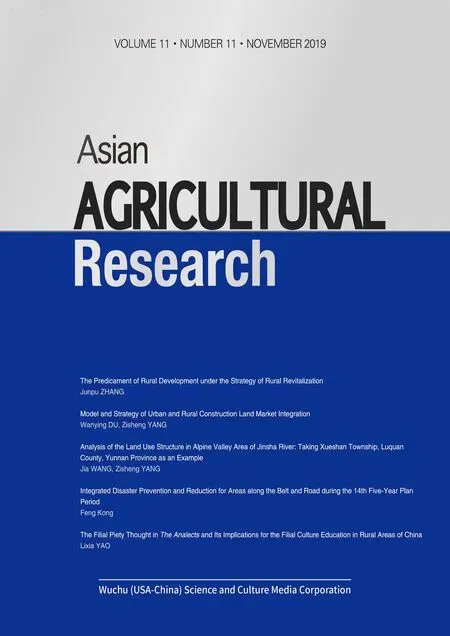Yield Gap Analysis of Wheat in Rice-wheat Rotation Regions of Anhui Province, China
2019-12-17*
*
1. Crop Research Institute, Anhui Academy of Agricultural Sciences, Hefei 230031, China; 2. Department of Environmental Sciences, COMSATS University Islamabad, Vehari Campus 61100, Pakistan
Abstract The present study was planned to analyze the yield gap of wheat and its production constraints in order to explore the approaches for narrowing the yield gap of wheat in different wheat-rice rotation regions of Anhui Province. The production status and limiting factors of wheat in three rice-wheat rotation regions which are named Region I, Region II and Region III were surveyed by using participatory rural appraisal method. The personnel, who were engaged in wheat production in rice-wheat rotation regions of Anhui Province, mainly ageing from 41 to 60, accounted for 79% of the total personnel in the regions. There were significant differences in yield of wheat which was planted after rice in Anhui. The yield was ranging from 8 907.00 to 2 700.00 kg/ha from north to south with an average of 4 978.5 kg/ha, and the rank of overall average yields at province level was Region I (5 685.60 kg/ha)> Region II (5 600.10 kg/ha)>Region III (3 048.60 kg/ha). The average yield gap of wheat in wheat-rice rotation regions at province level was up to 2 637.00 kg/ha, and the extreme yield gaps per hectare in the same region were 2 778.00 kg (Region I), 2 502.00 kg (Region II) and 1 575.00 kg (Region III) respectively. The objective constraints were Fusarium head blight and pre-harvest sprouting; the subjective constraints were variety selection and layout, poor sowing quality and low seedling quality; social constraints were high cost, low market price and poor efficiency; and ecological constraints were poor soil texture, soil infertility and poor water-and-fertilizer retention. The yield gap of wheat in rice-wheat rotation regions can be effectively reduced by improving yield potential of low-and-medium-yielding fields. Selecting appropriate wheat varieties and layout, constructing disease forecast system, improving agricultural machinery and social service organizations of plant protection, and strengthening scientific training as well as technological training of new agricultural operators and agricultural machinery technicians are the core means to narrowing the yield gap of wheat in rice-wheat rotation regions at province scale.
Key words Rice-wheat rotation, Yield gap, Production Constraints, Wheat, Climatic factors, Disease factors, Policy factors
1 Introduction
With the increase of global population and the reduction of arable land, food shortage has become a worldwide severe concern[1]. The world population had already increased from 6.4 billion in 2004 to 7.4 billion in 2016, and it is expected to reach 9.4 billion by 2050[2]. To keep up with the pace of population growth and food consumption patterns, the future global food security requires agricultural production in 2050 to be 60% more than that in 2010[3]. A feasible way to meet the estimated production demand is to derive more agricultural output from the existing arable land. This can be accomplished by reducing the gap between farmers’ actual crop yields and yields that are potential if optimum management is adopted, which is so-called ‘yield gap’[4].
Differences in crop yields among seasons, among regions and among varieties had long been noticed since the beginning of agriculture. However, the concept of ‘yield gap’ was firstly proposed by de Datta during late 1970s, and is defined as the difference between the actual crop yields harvested by farmers and those obtained at the experimental stations. Fischeretal. pointed it as the difference between the highest output of the farmer and the actual output. Many considered the maximum yield of a given crop cultivar under defined climatic conditions, while avoiding water and nutrient limitations and yield reductions due to pests and diseases, as the yield potential or potential yield of the crop[5]. Factors leading to yield gap are called ‘yield constraints’[6]. Various socio-economic, ecologic, biotic and abiotic factors are linked to the formation of crop yield gap, and several arithmetic models have been developed in quantifying the food production capacity of a given crop under certain eco-conditions[7-10].
China is both the largest food producer and consumer. With less than 9% of the world’s arable land, it bears the burden of feeding nearly 21% of the world’s population[3]. Wheat (TriticumaestivumL.) is the most important staple food in China. In 2016, over 24.3 million ha of wheat were harvested with a total grain production of nearly 131.7 million t, which took up 11.06% and 17.57% of the world’s total, respectively (NBS, 2016). Studies on yield gap of wheat, targeting at decreasing the gap, increasing the farmers’ actual production and guaranteeing the national food safety, have already been conducted in China[11-15].
Wheat is the largest food crop in Anhui Province. In 2018, 2 875 860 ha of wheat (12.29% of the nation’s total) with 16 074 500 t of grain (12.52% of the nation’s total) was produced in the provinces, which made it the third biggest wheat producing province in China following Henan and Shandong Provinces. Geographically, there are two big rivers running through Anhui. Yangtze River crosses the province around 30° N and Huai River crosses it around 31-32° N. The two rivers roughly divide the province into three ecological regions of wheat production,i.e. region beyond and along the Huai River (Region I), region between the Yangtze and Huai rivers (Region II)and region along the Yangtze River (Region III). Such geospatial characteristics lead to two of the most important wheat production patterns,i.e. wheat rotated either with rice (mostly to the south) or with maize (mostly to the north). According to a field survey from the Anhui Provincial Wheat Industrial Technology System (APWITS), the cultivation acreage of wheat under rice-wheat rotation pattern reached 1.20 million ha in 2014. However, because of the wide north-south span of rice-wheat rotation region, Anhui Province has complicated topography and landform, multiple production conditions, cultivation methods, limiting factors, and development potential which cause uneven development of wheat production. Historical high-yield record of wheat yield was over 9 t/ha, and the lowest farmer-field yield was under 3 t/ha. Detailed information on wheat yield gap in Anhui wheat-rice rotation regions are very limited at present. Narrowing down the regional difference in yield is a key issue to be solved immediately[13,16-17].
A lot of previous studies that concerning wheat yield gap had been carried out[18]. It is generally believed that wheat yield gap is related to variety selection, fertilization level and prevention of plant disease and insect prevention and control. Complex distribution of rice-wheat rotation regions, great differences of the yield and significantly different cultivation are limiting wheat production of Anhui province. Nevertheless, a few relevant studies are conducted concerning the cause of yield gap and means of narrowing the gap. In this study, a participatory rural assessment method[19]was adopted to assess the differences in yield and production constraints of wheat in the three rice-wheat rotation regions of Anhui Province. Surveys provide detailed information on farm labor, input choice, extension access, and other key determinants of productivity. Based on the investigation and statistics of different rice-wheat rotation areas in Anhui Province, this paper aims at improving the comprehensive production capacity, quality and efficiency of rice-wheat rotation areas by analyzing the limiting factors, and exploring the main ways to reduce the yield gap in Anhui Province.
2 Material and methods
2.1 Survey areaWheat production status in three ecological regions under rice-wheat rotation pattern was surveyed (Fig.1). Region I is the region along the Huai River. Two counties in this region, namely Huaiyuan County (116°45′-117°09′ E, 32°43′-33°19′ N) and Fengtai County (116°21′-116°56′ E, 32°33′-33° N), were chosen for the survey.Region II is the region between Yangtze and Huai rivers. Two cities, namely Tianchang City (119.00 E, 32.70 N) and Lu’an City (116°49′9″ E, 31°30′9″ N), were chosen for the survey.Region III is the region along the Yangtze River. One city, namely Tongling City (117°42′00″-118°10′6″ E, 30°45′12″-31°07′56″ N) was chosen for the survey.
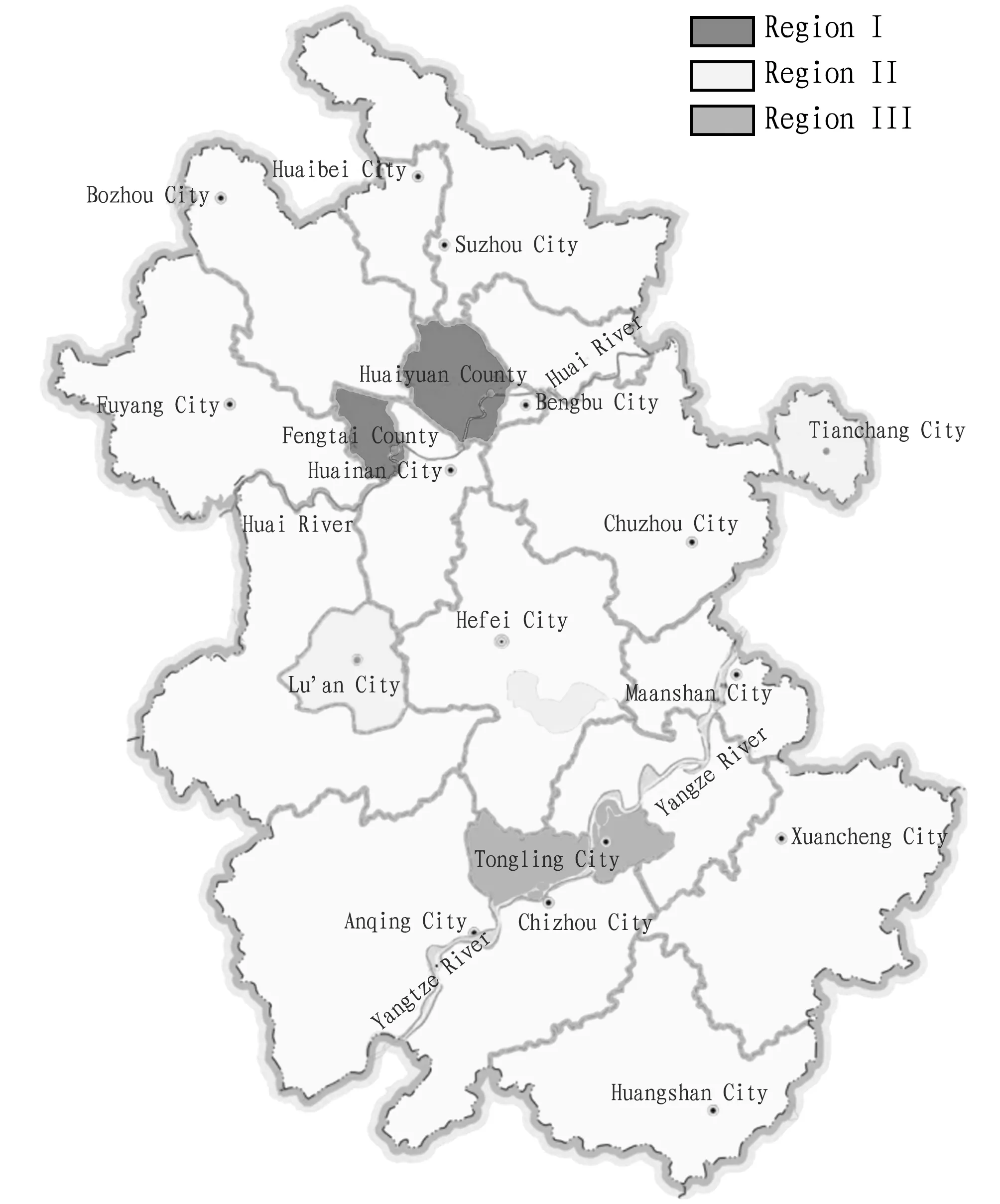
Fig.1 Survey area in rice-wheat rotation regions in Anhui Province
2.2 Participatory rural assessment by questionnaireA total of 504 randomly selected households in the above-mentioned counties (or cities) were surveyed following participatory rural assessment method. Questionnaires of wheat yield and productive efficiency were designed and provided by Chinese Academy of Agricultural Sciences (Table 1). Targeted information was fallen into five categories: (i) production information : age of the farmer participants, wheat acreage, yield output, input (costs in fertilizers, machinery, labors,etc.) and agricultural benefits; (ii) constraint factors: cold stress during mid-late spring, impacts of pre-harvest sprouting and Fusarium head blight affection,etc; (iii) management strategies: cultivar selection, pest and disease control strategy,and cultivation management techniques; (iv) social influences: low market price,poor efficiency,large investment, high cost and chaotic seed market; (v) ecological factors: barren soil, severe soil erosion, soil salinity, poor soil quality, precipitations and solar radiations,etc.
2.3 Data collection and analysisEach participant gave his/her own evaluation or estimation of the impacts of various factors on wheat yields. The surveyed data were divided into different categories and worked out the ratio of each item of the total showing as the percentage of constraints impact of each parameter.
Table 1 Limiting-factor survey in rice-wheat rotation regions in Anhui Province
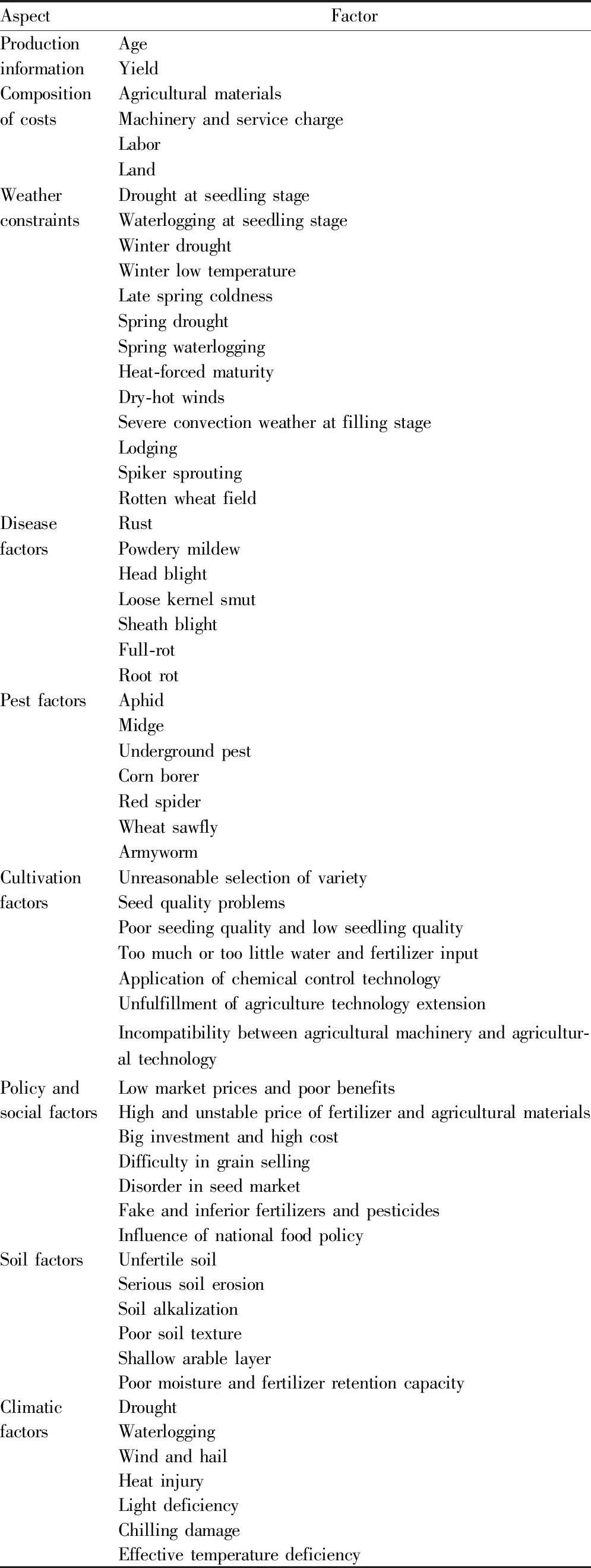
AspectFactorProductionAgeinformationYieldCompositionAgriculturalmaterialsofcostsMachineryandservicechargeLaborLandWeatherDroughtatseedlingstageconstraintsWaterloggingatseedlingstageWinterdroughtWinterlowtemperatureLatespringcoldnessSpringdroughtSpringwaterloggingHeat-forcedmaturityDry-hotwindsSevereconvectionweatheratfillingstageLodgingSpikersproutingRottenwheatfieldDiseaseRustfactorsPowderymildewHeadblightLoosekernelsmutSheathblightFull-rotRootrotPestfactorsAphidMidgeUndergroundpestCornborerRedspiderWheatsawflyArmywormCultivationUnreasonableselectionofvarietyfactorsSeedqualityproblemsPoorseedingqualityandlowseedlingqualityToomuchortoolittlewaterandfertilizerinputApplicationofchemicalcontroltechnologyUnfulfillmentofagriculturetechnologyextensionIncompatibilitybetweenagriculturalmachineryandagricultur-altechnologyPolicyandLowmarketpricesandpoorbenefitssocialfactorsHighandunstablepriceoffertilizerandagriculturalmaterialsBiginvestmentandhighcostDifficultyingrainsellingDisorderinseedmarketFakeandinferiorfertilizersandpesticidesInfluenceofnationalfoodpolicySoilfactorsUnfertilesoilSerioussoilerosionSoilalkalizationPoorsoiltextureShallowarablelayerPoormoistureandfertilizerretentioncapacityClimaticDroughtfactorsWaterloggingWindandhailHeatinjuryLightdeficiencyChillingdamageEffectivetemperaturedeficiency
3 Results
3.1 Constitution of wheat-producing farmers under wheat-rice rotation pattern in Anhui, ChinaThe survey suggested that the personnel, aged from 41 to 60, were mainly engaged in wheat production in rice-wheat rotation regions, accounting for 79% of the total farmers in the regions (Fig.2). The younger generation of farmers,i.e. under the age of 40, took only 7.62%. That was even less than the number of elder farmers over 61, which made up 12.85% of the surveyed farmers.

Fig.2 Employment age structure in rice-wheat rotation regions in Anhui Province
3.2 Production of wheat in rice-wheat rotation regions of Anhui province, China
3.2.1Spatial differences in wheat yield. The survey suggested that among the farmers, their actual wheat yield varied from 8 907.00 to 2 700.00 kg/ha, as 4 978.50 kg/ha on average. There showed a spatial difference in wheat yield under wheat-rice rotation pattern in Anhui province, giving a decreasing yield tendency from the north to the south. The average yield in Region I was 5 685.60 kg/ha, which was 1.53% higher than Region II (5 600.10 kg/ha), and 86.50% higher than Region III (3 048.60 kg/ha) (Table 2). The average inter-regional yield gap of wheat in wheat-rice rotation regions of Anhui Province was up to 2 637.00 kg/ha. The extreme yield gaps per hectare in the same area of Region I, Region II and Region III were 2 778.00 kg, 2 502.00 kg and 1 575.00 kg. Variety selection, farming patterns and field management levels were the main factors which result in yield gap in the same regions. Precipitation and corresponding diseases and solar radiation length were the main factors which were leading to the yield gap in different regions from north to south.
Table 2 Yield levels in rice-wheat rotation regions in Anhui Province
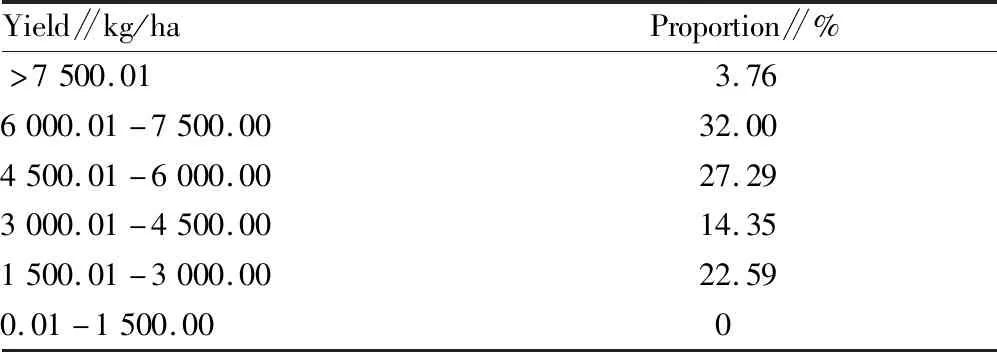
Yield∥kg/haProportion∥%>7500.013.766000.01-7500.0032.004500.01-6000.0027.293000.01-4500.0014.351500.01-3000.0022.590.01-1500.000
3.2.2Production costs and benefits of wheat production. The benefit of wheat planting is directly related to the enthusiasm of farmers. As shown in Fig.3, the average cost of wheat in rice-wheat rotation regions of Anhui Province was 1 716.45 USD, in which the costs of agricultural capital, mechanical operating, labor and land were 671.30, 399.75, 198.47 and 446.93 USD/ha, respectively. The cost composition of wheat production varied among regions. Generally, agricultural capital cost, mechanical operating cost and labor cost were higher, accounting for 39.11%, 23.29%, and 26.04%, respectively. The lower labor cost indicated higher mechanization degree of planting in rice-wheat rotation regions in Anhui province. Calculated at national grain protective price of 0.35 USD/kg, the yield per hectare was 4 978.50 kg, the average income per hectare was 1 742.48 USD, and the direct net benefit was only 26.48 USD/ha. More than 50.00% of the rice-wheat rotation fields were at varying degrees of loss. It is worth considering whether wheat is suitable for planting in rice-wheat rotation regions such as Region II and Region III. Regional structure adjustment and replacement of planting patterns might be a new attempt of efficient resource allocation in rice-wheat rotation regions.
3.3 Objective constraints affecting wheat productionSeveral biotic factors were considered affective to the grain production of wheat rotated with rice. Fusarium head blight (causal agentFusariumspp.) was the most important constraint leading to 51.09% of the yield losses. The main insect factors were aphid (Diuraphisnoxia) and wheat mite (Penthaleusmajor), accounting for 54.17% and 38.54%, respectively. The typical disastrous factors limiting the yield potential of wheat were basically the same in different rice-wheat rotation regions (Fig.4, Fig.5A, Fig.5B). The main meteorological factors limiting wheat production in rice-wheat rotation regions were ear germination which is due to continuous rain during harvest of wheat , Low winter temperature, Spring water-logging and Heat-forced maturity, accounting for 17.26%, 11.90%, 12.50% and 11.31%, respectively.
3.4 Subjective constraints affecting wheat production
3.4.1Cultivation and management techniques restricting wheat production. Cultivation and management techniques restricting wheat production in rice-wheat rotation regions of Anhui Province are displayed in Fig.6A. The main restrictive factors were Unreasonable selection of variety, poor seeding quality and low seedling quality and incompatibility between agricultural machinery and agricultural technology, accounting for 23.16%, 22.94% and 16.23%, respectively.
3.4.2Social factors restricting the enthusiasm of wheat production. The general benefits of policy and the composition of social impact are presented in Fig.6B. The social factors restricting the enthusiasm of wheat production and grain growing in rice-wheat rotation regions of Anhui Province were Low market price, poor efficiency and large investment-High cost, high and unstable price of fertilizer and agricultural materials, accounting for 24.60%, 23.39% and 18.95%, respectively.
3.4.3Ecological factors limiting wheat production. Soil factors and climatic factors restricting wheat production in rice-wheat rotation regions of Anhui Province are shown in Fig.7A and Fig.7B. The main soil factors influencing wheat production were poor soil texture, infertile soil, and poor moisture and fertilizer retention, accounting for 26.46%, 17.80%, and 18.97%, respectively. The proportions of influences of various climatic factors on wheat production were roughly the same from north to south.
4 Discussions
4.1 Improving the yield potential of low and medium-yielding fieldsThe research on yield gap aims to reveal the magnitude and geographical differences of crop yield gap, to explain the reasons for its formation and to take the measures to narrow the yield gap[18]. The survey results showed that the yield variation of wheat in rice-wheat rotation regions was 8 907.00-2 700.00 kg/ha and the overall yield decreased progressively from north to south. The yield gap among farmers was different in the intra region, the yield gaps in Region I, Region II and Region III were 2 778.00, 2 502.00 and 1 575.00 kg/ha respectively. The wheat production in the region was characterized by low unit area yield, high proportion of low and medium yielding fields, large regional variation in yield gap, mixed varieties, extensive field management, low utilization of water and fertilizer , and poor incompatibility between agricultural machinery and agronomy. The major reason was erratic occurrence and amount of rainfall before sowing which caused a series of problems such as poor land preparation, poor sowing quality, incomplete emergence, small population, low uniformity and unevenness[20]. Fanetal.[21]pointed out that water shortage was found even in irrigation and rainwater rich areas, which was similar to the main cause analyzed in this survey. Furthermore, variety selection and layout, fertilizer application and field management techniques are also indispensable factors leading to yield gap. The yield gap of wheat in rice-wheat rotation regions could be narrowed by promoting new machinery and cultivation patterns, selecting varieties with strong tillering and population compensation, strengthening farmland infrastructure, improving water and fertilizer utilization efficiency, having the rational quantification in transformation of medium- and low-yielding fields and increasing the production of yield potential, which supported by the idea of Liuetal.[22].
4.2 Development of appropriate wheat varieties and layouts
Survey results showed that there were many issues in rice-wheat rotation regions in Anhui Province, such as many miscellaneous varieties, few breakthroughs in varieties, slow regeneration of improved varieties, large variation in yield gap between varieties, and low planting benefits. Meanwhile, these issues were urgently to be solved such as high rainfall and less seedling formation at sowing, flowering and harvest periods, frequent prevalence of head blight, high risk of ear germination at harvest period, low commercialization rate, unsound grain exceeding the standard, and double reduction of yield and quality. How to improve the yield potential of rice-wheat area and what technical measures to reduce cost, improve quality and efficiency are worth further discussion. There are constraints in wheat production such as the existence of unsound kernels exceeding limits and the decrease of yield, quality and efficiency. On this basis, selection and utilization of genetic improved wheat varieties, including increased resistance to Fusarium head blight, pre-harvest sprouting and enhanced tolerance to waterlogging is thus the priority for promoting efficiency of pro-duction and safety of end-products. Firstly, the strategy is necessary in producing semi-winter type of wheat, which is of high yield potential, in the rice-wheat rotation regions of Region II and Region III. Secondly, based on disease resistance and stress tolerance, strengthening breeding and selection of new early-maturing wheat varieties with strong cold resistance and high yield will not only reduce the yield reduction caused by cold stress, too early or too late sowing, drought, cold-affected seedlings or young panicles and reduced number of panicles or grains, but also guide spring (red-wheat) varieties with resistance (tolerance) to head blight and other diseases in the field extending to Region I and Region II. It is also a tentative measure to narrow the yield gap and variety regeneration from the perspective of variety utilization and layout.
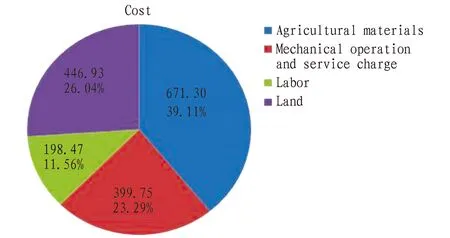
Fig.3 Composition of production cost in rice-wheat rotation regions in Anhui Province(unit:USD)
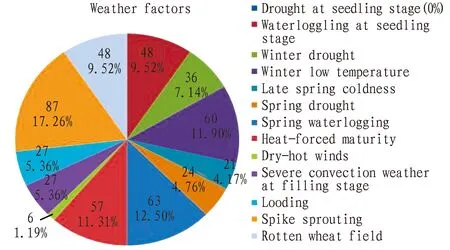
Fig.4 Weather factors restricting wheat production in rice-wheat rotation regions of Anhui Province

Fig.5 Disease (A) and pest (B) factors restricting wheat production in rice-wheat rotation regions of Anhui Province

Fig.6 Cultivation (A) and policy (B) factors restricting wheat production in rice-wheat rotation regions of Anhui Province

Fig.7 Soil (A) and climatic (B) factors restricting wheat production in rice-wheat rotation regions of Anhui Province
4.3 Establishment of disease forecasting system and improvement of social service organizations of agricultural machinery and plant protectionThe factors influencing wheat yield potential (Fig.5A, B) reflected that the typical constraints were basically the same in different regions , mainly including ear germination, head blight and aphid. Due to the specificity of pest and disease risk in rice-wheat rotation system, the annual regional changes and evolution dynamics are complex, and the "window period" for effective prevention and control of diseases (pests) is short. Therefore, it is necessary to increase the prediction, forecast the occurrence regularly, control risk of diseases (insects and grass), and release early warning information timely and accurately in various production areas. Realizing time and effectively control of diseases (insects and grass) is the guarantee to improve wheat production in rice-wheat rotation regions of Anhui province.
4.4 Technical training for the new generation of farmers and techniciansThere are significant differences in planting patterns, agricultural machinery equipment, and agricultural machinery and technology supporting level among rice-wheat rotation regions in Anhui Province. Under the background of large-scale agricultural production, especially the new situation of crop straw being completely returned to the field, comprehensive supporting of agricultural machinery and technology has become a key step of wheat production in rice-wheat rotation system. Research and discussion on new types of compound operating machinery for returning straw to the field, and updating the technical knowledge reserve and working level of agricultural technicians become important links to improve tillage level, sowing quality and population uniformity and obtain high yield in rice-wheat rotation region. Meanwhile, it is necessary to enhance the annual variety layout of rice and wheat and screen variety combinations and matching technologies with reasonable stubble rotation and efficient utilization of light and temperature resources in rice-wheat rotation regions.
杂志排行
Asian Agricultural Research的其它文章
- Application Effects of Stabilized Fertilizer with Reduced Amount and Frequency on Rice
- Characteristics of Changes in Energy Consumption of Rural Residential Buildings from the Perspective of Province and Recommendations
- Contents of Heavy Metals in Typical Aquatic Products from a Market in Binzhou
- Analysis of the Land Use Structure in Alpine Valley Area of Jinsha River: Taking Xueshan Township, Luquan County, Yunnan Province as an Example
- Assessment on Ecological Capital of Small Towns: A Case Study of Baita Town, Weifang
- Effects of Different Storage Temperatures on Shelf Life and Quality of Strawberry Fruit after Hot Water Treatment
